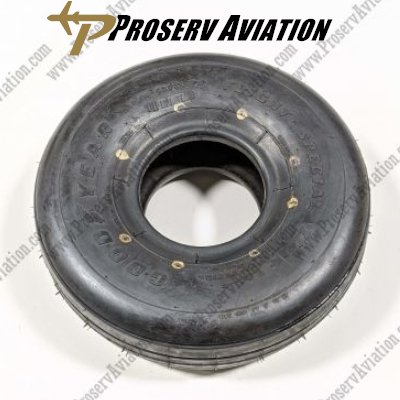Goodyear Flight Special II 505C41-4


In Stock | Best Price | Best Service |
Goodyear Flight Special II , 4 Ply, 120 mph Speed Rating, Light Aircraft Tire
Specifications
| Brand | Goodyear Flight Special II |
| Part Number | 505C41-4 |
| Size | 5.00 x 5 |
| Ply Rating | 4 PR |
| Speed Rating | 120 MPH |
| Type | TT (Tubetype) |
| Typical Position | Main Landing Gear (MLG) |
| Typical Aircraft Application | Cessna Skycatcher |
| Load Rating | 800 Lbs |
| Rated Inflation (PSI) | 31 |
*Alternative Part Numbers #072-308-0 | 301-015-420
Goodyear Flight Special II Features
The Goodyear® Flight Special II™ is the economical choice for general aviation tires. This popular replacement tire for light aircraft maximizes value without compromising on quality. It delivers reliable performance, landing after landing.
The Flight Special II™ features durable construction and excellent traction for extended tread life. Its unique design includes triple-tempered nylon cord strands, ensuring optimal strength and uniformity.
Goodyear Flight Special II 505C41-4 Available to buy at ProservAviation
Frequently Asked Questions (FAQ) — Aircraft Tires
1. What are the main types / constructions of aircraft tires?
- Bias-ply (bias) tires: Plies (fabric layers) are laid at alternating angles less than 90° to the tread centerline. These have traditionally been common in aviation. (They tend to have stiffer sidewalls and more internal shearing at high loads.)
- Radial tires: Plies are oriented approximately 90° (perpendicular) to the tread centerline, and then stabilized with circumferential belts. Radials often provide better heat dissipation and more uniform wear.
- Also, tires may be tube-type (with an inner tube) or tubeless (with a built-in inner liner to retain gas).
2. How often should tire pressure be checked?
- Tire pressure should be checked daily or before first flight, when the tires are cold (at ambient temperature).
- Aircraft tire assemblies can lose up to 5% of inflation pressure in 24 hours and still be considered within a normal range. (
- Use dry nitrogen when possible (less reactive, more stable) for inflation.
- Be aware of temperature effects: a change of ~3 °C (5 °F) corresponds to ~1% pressure change.
3. What are the criteria for removing a tire from service?
Tires should be removed whenever they show signs that compromise safety or performance. Some common removal criteria:
- Tread worn down to the base of any groove, or to the minimum depth specified by the manufacturer.
- Cracks, cuts, or groove cracking that expose internal fabric / structural plies or undercut tread ribs.
- Sidewall damage (cuts, cracks) that penetrate down to the structural plies.
- Internal separations, bulging, distortions in the casing, or evidence of heat damage or slipping (e.g. rubber reversion).
- Deep flat spots or vibration problems that cannot be corrected by balancing.
The specific wording and threshold recommendations are covered in FAA Advisory Circular AC 20-97B §7 (Tire removal & in-service inspections) and in manufacturer manuals.
4. Can aircraft tires be balanced like car tires?
Yes — balancing an aircraft tire/wheel assembly is a beneficial practice (though not always practiced):
- Balancing helps reduce vibration, gear component wear, and uneven tire wear.
- The standard practice is to align the red dot (light spot) on the tire with the valve stem (heavy point) before mounting.
- Dynamic balancing (spin-balancing) of the tire + wheel is ideal, but many aviation shops lack this capability.
5. How does heat affect aircraft tires, and how is it managed?
- Heat is one of the major stressors for aircraft tires, especially during high-speed operations and heavy braking.
- High heat can degrade rubber (reversion), weaken bond interfaces, cause internal separation, or accelerate aging.
- To mitigate heat:
- Use compounds and reinforcing materials that resist high temperature degradation.
- Use radial construction for improved heat dissipation.
- Maintain correct inflation to reduce internal flexing and hysteresis heating.
- Limit extended high-speed taxi or braking whenever possible.
- In storage, keep tires in a cool, dry environment (away from ozone, UV, chemicals).
- Use compounds and reinforcing materials that resist high temperature degradation.
6. Does tire age matter?
- Age on its own is not always a disqualifier, provided the tire continues to meet inspection, visual, and inflation criteria.
- However, many operators rotate inventory (FIFO) to avoid excessively old tires in use.
- Stored assemblies (mounted + inflated) may need re-inspection after long intervals (e.g. after 12 months).
7. What are some best practices for tire handling, mounting, and storage?
- Store tires in a cool, dry place away from direct sunlight, ozone sources (e.g., electric motors), fuel/oil/hydraulic fluids.
- Store tires vertically or flat (per manufacturer guidance) to avoid distortion.
- When mounting/demounting, use proper tools, follow procedures, use safety cages (because of explosion risk), and allow cooling before deflating.
- Inflate new assemblies and allow a “stretch” period (often ~12 hours) before full use, then re-check pressure.
- After mounting, perform a 24-hour pressure retention check to verify no leaks.
- Avoid stacking or hanging tubes over pegs or sharp edges.
